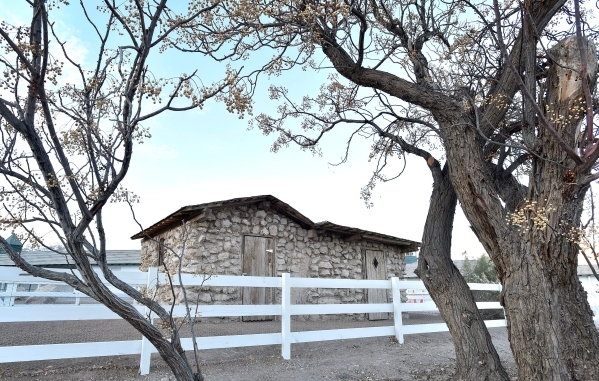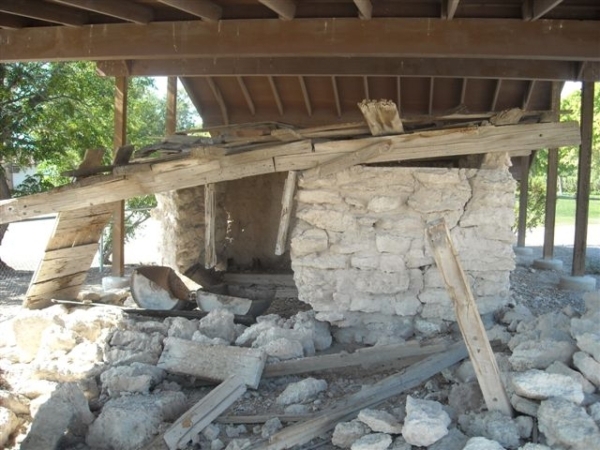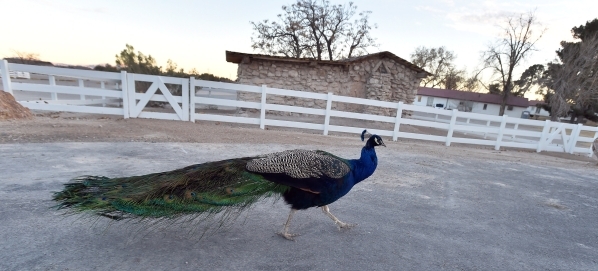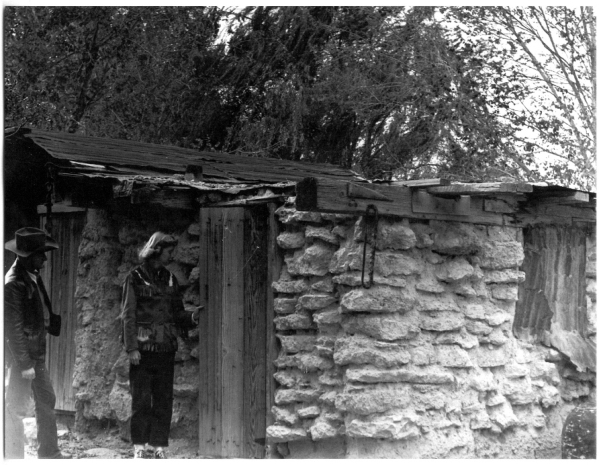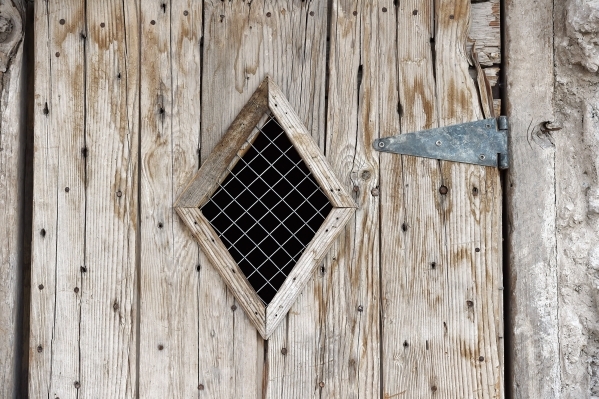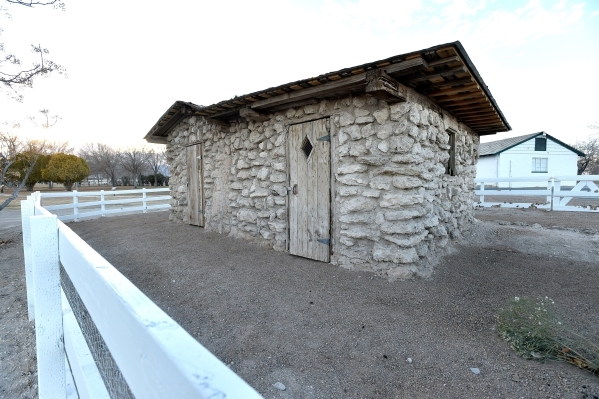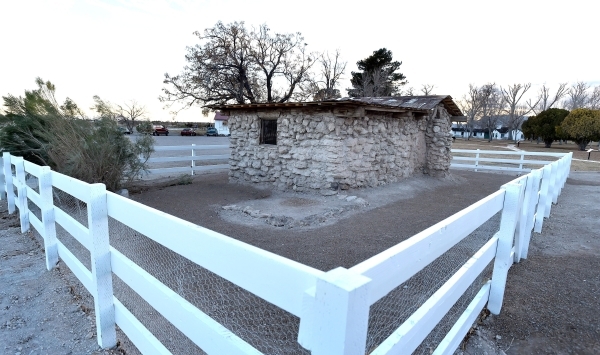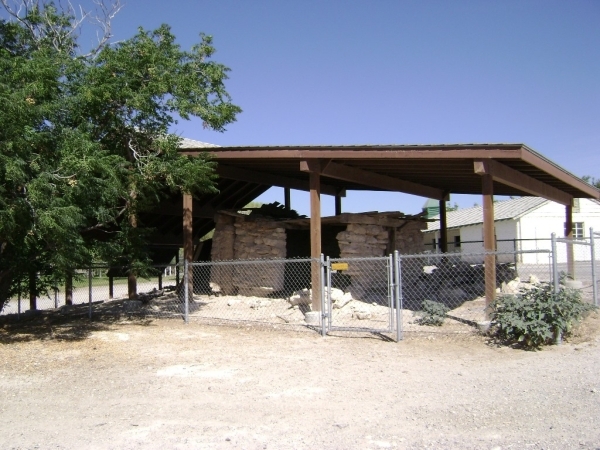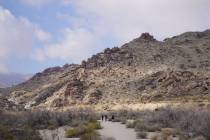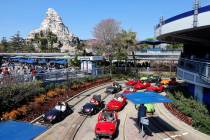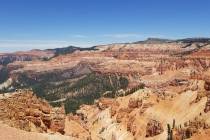City restores historic Tule Springs adobe hut
It was only a matter of time before the old adobe hut at Floyd Lamb Park at Tule Springs would have been erased from history, said Courtney Mooney, the city of Las Vegas' historic preservation officer, recalling the structure's state five years ago.
The historic building, believed one of the few of its kind left in Southern Nevada, was a shadow of its former self. Two exterior walls had partially collapsed. Wooden beams jutted from the roof at odd angles, while caliche blocks and stray scraps of wood and metal littered the ground around it.
"We had a really bad rainstorm in 2012, and parts of the adobe hut had already been collapsing," Mooney said. "There were already issues, and we had been told that kids were climbing on it, and we had animals nesting in it. And all these things were causing further deterioration."
Add to that the risk of someone getting hurt at the site, and it was obvious something needed to be done. "We were in danger of losing the entire building altogether if we had one more big storm event," Mooney said. "So we prioritized."
The adobe hut became the second project undertaken as part of a city plan to restore 26 buildings at Tule Springs Ranch, she said. The first was the foreman's house, now a visitor's center.
Workers completed restoration in late December, and visitors now can see how the adobe hut, built in the early 1900s, looked in long-ago days.
"We really don't have very many buildings that are that kind of style in Las Vegas," Mooney said.
Beyond the adobe hut's age and rarity, she added, it is the only building left from the time when the Tule Springs area was a pit stop along a wagon road that led to mining camps north of Las Vegas. "There was kind of a little town site there. It had a restaurant, a hotel, probably a little tent city. No other resources exist from that time in that area."
The adobe served as storage, a blacksmith shop and temporary residence for Burt Nay, who purchased 40 acres in the Tule Springs area in 1917.
"He lived out there and started making improvements, and then it changed hands and developed and grew until it became what we know it as today," Mooney said. "If that building wasn't there to provide shelter, he might have moved on, and we might not have the Tule Springs Ranch."
The $98,000 project, funded by grants from the Nevada State Commission for Cultural Centers and Historic Preservation and the Commission for the Las Vegas Centennial, was finished for a third of the estimated $300,000 cost and in half the expected time.
"It's quite an accomplishment," Mooney said, crediting the city public works department's involvement as key.
The department was able to salvage some existing materials, including fallen caliche blocks, and reuse them, lowering material costs, said Patrick Batte, an architect for the department. New blocks were quarried from the park's "badlands" area, and other new materials were necessary to ensure the reconstruction met with current seismic and other city codes.
"With any one of these projects, there's always a dichotomy. You've got one foot in the past and one foot in the present," Batte said. "The challenges are to maintain the appearance and the historical integrity of the project but yet have it maintained and upgraded to code."
Batte and Mooney praised the restoration team, including city staff, contractor Accelerated Construction and structural engineer Mel Green of Mel Green and Associates.
"Any successful historical project always has to begin with good research," Batte said, "And we were fortunate that we have a team and a staff that provided the documentation that was necessary to make the project successful."
With any historic building restoration come surprises, and often the need to adjust to them, Mooney said.
"There are things you can sketch out as much as you want, but when you get out into the field and actually start putting it together, you have to make some changes to make it all fit," she said.
Mooney described how the team used concrete beams to strengthen the structure and devised a way to disguise them to meld with the adobe style.
Another surprise came from a close examination of the hut's construction that has led team members to believe the structure was built in two stages, Mooney said.
Perhaps the best revelation was the discovery of artifacts long buried under dirt. "We have photographic evidence that those things were from at least the '40s," Mooney said.
Among the finds were an original door, a shelf, hinges, nails, parts of the original tin roof and a piece of equipment that may be a bracket.
Archaeologist Colleen Beck, a member of the city Historic Preservation Commission, and a colleague collected and stored the items to be cataloged and later displayed inside the locked hut to be viewed through its windows.
Next up for restoration is a duplex where actress Terry Moore, a paramour of Howard Hughes, once stayed.
"Tule Springs Ranch was a guest ranch where hopeful divorcees would come and wait out their six-week residency so they could get a divorce," Mooney explained. "This duplex is a good example of a place they would have lived, so that's our next priority."
Tule Springs Ranch, located at 9200 Tule Springs Road, is open from 9 a.m. to 5 p.m. The cost of entry is $6 per car.
Contact Marian Green at mgreen@reviewjournal.com or 702-387-5205. Find her on Twitter: @mgreen0708



